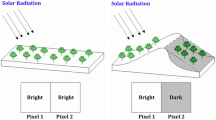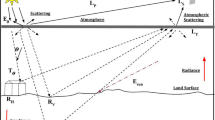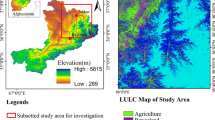Abstract
Irregular shape of terrain causes variable illumination angles and diverse reflectance values within same land cover type in optical remote sensing image. It causes problems in image segmentation and misclassification (snow with other land cover). This perception leads to develop an empirical-statistical based topographic correction (ESbTC) algorithm for reflectance modeling after compared with existed topographic correction methods like Cosine correction, C-correction, Minnaert correction, sun–canopy–senor with c-correction (SCS + C) and slope matching, in the context of snow reflectance. An image based atmospheric correction has used in present study included dark-object subtraction (DOS) and effect of Rayleigh scattering on the transmissivity in different spectral bands of AWiFS and MODIS image data. The performance of different models is evaluated using (1) visual analysis, (2) change in snow reflectance on sunny and shady slopes after the corrections, (3) validation with in situ observations and (4) graphical analysis. Further snow cover area (SCA) has been estimated with normalized difference snow index (NDSI) and validated with support vector machine (SVM), a supervised classification technique. The result shows that the proposed algorithm (ESbTC) and slope-matching technique could eliminate most of the shadowing effects in Himalayan rugged terrain and correctly estimate snow reflectance from AWiFS and MODIS imagery as compared with in situ observations whereas other methods significantly underestimate reflectance values after the corrections.











Similar content being viewed by others
References
Chavez, P. S. Jr. (1996). Image-based atmospheric corrections revisited and improved. Photogrammetric Engineering and Remote Sensing, 62(9):1025–1036.
Chavez, P. S. Jr. (1989). Radiometric calibration of landsat thematic mapper multispectralimages. Photogrammetric Engineering and Remote Sensing, 55, 1285–1294.
Civco, D. L. (1989). topographic normalization of landsat thematic mapper digital imagery. Photogrammetric Engineering and Remote Sensing, 55, 1303–1309.
Colby, J. D. (1991). Topographic normalization in rugged terrain. Photogrammetric Engineering and Remote Sensing, 57(5), 531–537.
Gates, D. M. (1980). Biophysical Ecology. New York: Springer-Verlang.
Ghasemi, N., Mohammadzadeh, A., & Sahebi, M. R. (2013). Assessment of different topographic correction methods in ALOS AVNIR-2 data over a forest area. International Journal of Digital Earth, 6(5), 504–520.
Green, A. A., Berman, M., Switzer, P., & Craig, M. D. (1988). A transformation for ordering multispectral data in terms of image quality with implications for noise removal. IEEE Transactions on Geoscience and Remote Sensing, 26(1), 65–74.
Gu, D., & Gillespie, A. (1998). Topographic normalization of landsat TM images of forest based on subpixel sun-canopy-sensor geometry. Remote Sensing of Environment, 64, 166–175.
Hall, D. K., Riggs, G. A., & Salomonson, V. V. (1995). Development of methods for mapping global snow cover using moderate resolution imaging spectro-radiometer data. Remote Sensing Environment, 54, 127–140.
Hantson, S., & Chuvieco, E. (2011). Evaluation of different topographic correction methods for landsat imagery. International Journalof Applied Earth Observation and Geoinformation, 13, 691–700.
Hsu CW, Chang CC, Lin CJ (2007) A practical guide to support vector classification. National Taiwan University. http://ntu.csie.org/%7Ecjlin/papers/guide/guide.pdf
Kasten, F. (1962). Table of solar altitudes for geographical latitudes (CRREL Special Report, 57U.S). Hanover, New Hampshire: Army Corps of Engineers.
Kaufman YJ (1989) The atmospheric effect on remote sensing and its correction. In Theory and Application of Optical Remote Sensing (G. Asrar, Ed.), New York, pp. 341.
Kawata, Y., & Ueno, S. (1995). The surface albedo retrieval of mountainous forest area from satellite MSS data. Applied Mathematics and Computation, 69(1), 41–59.
Kruse, F. A., Boardman, J. W., & Huntington, J. F. (2003). Comparison of airborne hyperspectral data and EO-1 hyperion for mineral mapping. IEEE Transactions on Geoscience and Remote Sensing, 41(6), 1388–1400.
Liu, Y., Noumi, Y., & Yamaguchi, Y. (2009). Discrepancy between ASTER and MODIS derived land surface temperatures: terrain effects. Sensors, 9(2), 1054–1066.
Mishra, V. D., Sharma, J. K., & Khanna, R. (2010). Review of topographic analysis methods for the western Himalaya using AWiFS and MODIS satellite imagery. Annals of Glaciology, 51(54), 153–159.
Nichol, J., Hang, L. K., & Sing, W. M. (2006). Empirical correc-tion of low sun angle images in steeply sloping terrain: a slope matching technique. International Journal of Remote Sensing, 27(3–4), 629–635.
Pandya, M. R., Singh, R. P., Murali, K. R., Babu, P. N., Kirankumar, A. S., & Dadhwal, V. K. (2002). Bandpass solar exoatmospheric irradiance and Rayleigh optical thickness of sensors on board Indian remote sensing satellites-1B, −1C, −1D, and P4. IEEE Transactions on Geoscience and Remote Sensing, 40(3), 714–718.
Riano, D., Chuvieco, E., Salas, J., & Aguad, I. (2003). Assess-ment of different topographic corrections in Landsat-TM data for mapping vegetation types. IEEE Transactions on Geoscience and Remote Sensing, 41(5), 1056–1061.
Richter, R. (1998). Correction of satellite imagery over mountainous terrain. Applied Optics, 37(18), 4004–4015.
Sharma, S. S., & Ganju, A. (2000). Complexities of avalanche forecasting in Western Himalaya-an overview. Cold Regions Science and Technology, 3195–102.
Shepherd, J. D., & Dymond, J. R. (2003). Correcting satellite imagery for the variance of reflectance and illumination with topography. International Journal of Remote Sensing, 24(17), 3503–3514.
Singh, M., Mishra, V. D., Thakur, N. K., & Sharma, J. D. (2013). Statistical models for retrieval of Himalayan land-surface parameters for geomorphologic research. International Journal of Science and Research, 2(3), 330–340.
Smith, J. A., Lin, T. L., & Ranson, K. J. (1980). The lam-bertian assumption and landsat data. Photogrammetric Engineering and Remote Sensing, 46(9), 1183–1189.
Soenen, S. A., Peddle, D. R., & Cobure, C. A. (2005). SCS + C: a modified sun-canopy-sensor topographic correction in forested terrain. IEEE Transactions on Geoscience and Remote Sensing, 43, 2148–2159.
Sola, I., Gonzalez, A. M., Alvarez, M. J., & Torres, J. L. (2014). Synthetic images for evaluating topographic correction algorithms. IEEE Transactions on Geoscience and Remote Sensing, 52(3), 1799–1810.
Song, C., Woodcock, C. E., Seto, K. C., Lenney, M. P., & Macomber, S. A. (2001). Classification and change detection using Landsat TM data; when and how to correct atmospheric effects. Remote Sensing Environment, 75(2), 230–244.
Srinivasulu, J., & Kulkarni, A. V. (2004). Estimation of spectral reflectance of snow from IRS-1D, LISS-III sensor over the Himalayan terrain. Proceeding of Indian Academic Science (EarthPlanetary Science), 113, 117–128.
Teillet, P. M., Guindon, B., & Goodenough, D. G. (1982). On the slope aspect correction of multispectral scanner data. Canadian Journal of Remote Sensing, 8(2), 84–106.
Van Der Meer, F. (1996). Spectral mixture modeling and spectral stratigraphy in carbonate lithofacies mapping. Journal of Photogrammetry and Remote Sensing, 51, 150–162.
Xin, L., Koike, T., & Guodong, C. (2002). Retrieval of snow reflectance from Landsat data in rugged terrain. Annals of Glaciology, 34, 31–36.
Acknowledgment
The authors would like to thank Director Snow Avalanche Study establishment, Department of Defence Research and Development Organization (India) for providing necessary facilities in Field station and Remote Sensing & GIS research Laboratory.
Author information
Authors and Affiliations
Corresponding author
About this article
Cite this article
Singh, M., Mishra, V.D., Thakur, N.K. et al. Expansion of Empirical-Statistical Based Topographic Correction Algorithm for Reflectance Modeling on Himalayan Terrain using AWiFS and MODIS Sensor. J Indian Soc Remote Sens 43, 379–393 (2015). https://doi.org/10.1007/s12524-014-0414-4
Received:
Accepted:
Published:
Issue Date:
DOI: https://doi.org/10.1007/s12524-014-0414-4




